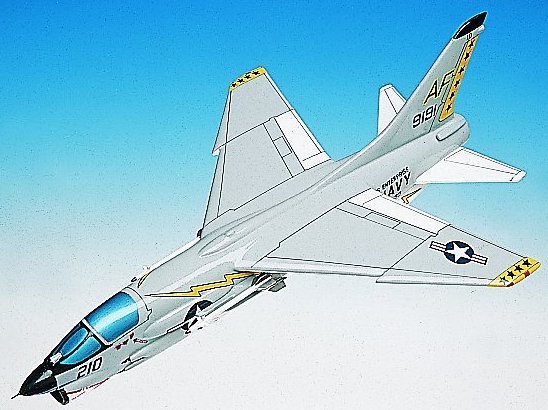|
|
|
 |
Vought
F8U Crusader |
 |
|
In September 1952, the Navy laid out for
competitive bid by eight aircraft manufacturing companies the
specifications for a new carrier-based fighter which, aside from
normal requirements for easy maintenance, folding wings and a
slow landing speed, also specified that it be able to exceed the
speed of sound in routine level flight.
Chance Vought
won the bid with its F8U Crusader that incorporated a 42-degree
swept-wing design to achieve the high speed requirement. The
wing was also unique in providing a two-position, variable
incidence wing which allowed the pilot to hydraulically raise it
7 degrees to enable the aircraft to land and takeoff at slow
speeds while maintaining the fuselage parallel to a carrier deck
or runway for excellent visibility by the pilot. Armed with
four- twenty mm cannons, the F8U was a gunfighter and considered
a pure air-superiority aircraft by its pilots. It was also
capable of carrying an ordnance load of 4,000 lbs including
AIM-9 "Sidewinder" heat seeking air-to-air-missiles,
Zuni air-to-ground rockets and "Bullpup" air-to-ground
missiles.
Significant accomplishments by the F8U
included a non-stop flight from an aircraft carrier in the
Pacific to one in the Atlantic; a non-stop transcontinental
flight speed record (723 mph) by a single engine aircraft set by
Major John Glenn, USMC (later to become famous as an astronaut
and U.S. Senator); participation in Lebanon patrol operations;
and photo-intelligence flights during the Cuban missile crisis.
F-8s were on-scene throughout the Vietnam conflict in
photographic, strike and fighter roles and took credit for
downing 18 MiGs. Eighty three Crusaders were lost in action
while 109 sustained major damage.
|
|
 |
F8E Crusader
Standard Series. 1/48th scale. 9.85" wingspan x
14" long.
No. AFN6D-ST. Only $129.95 |
|
